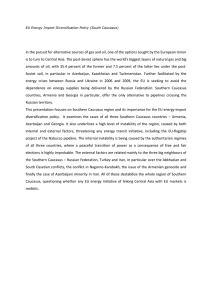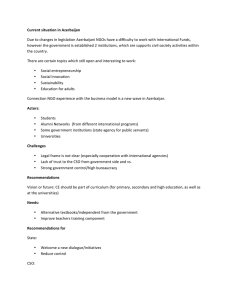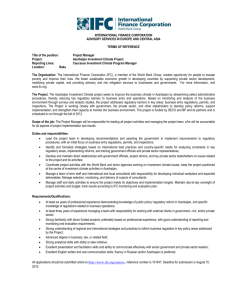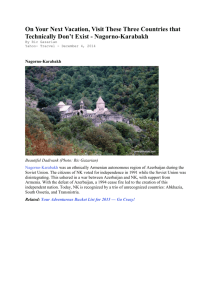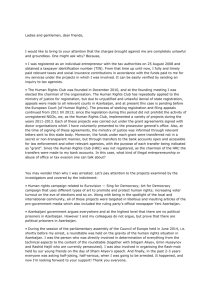Elkhan Mehtiyev PERSPECTIVES OF SECURITY DEVELOPMENT IN THE SOUTH CAUCASUS
advertisement
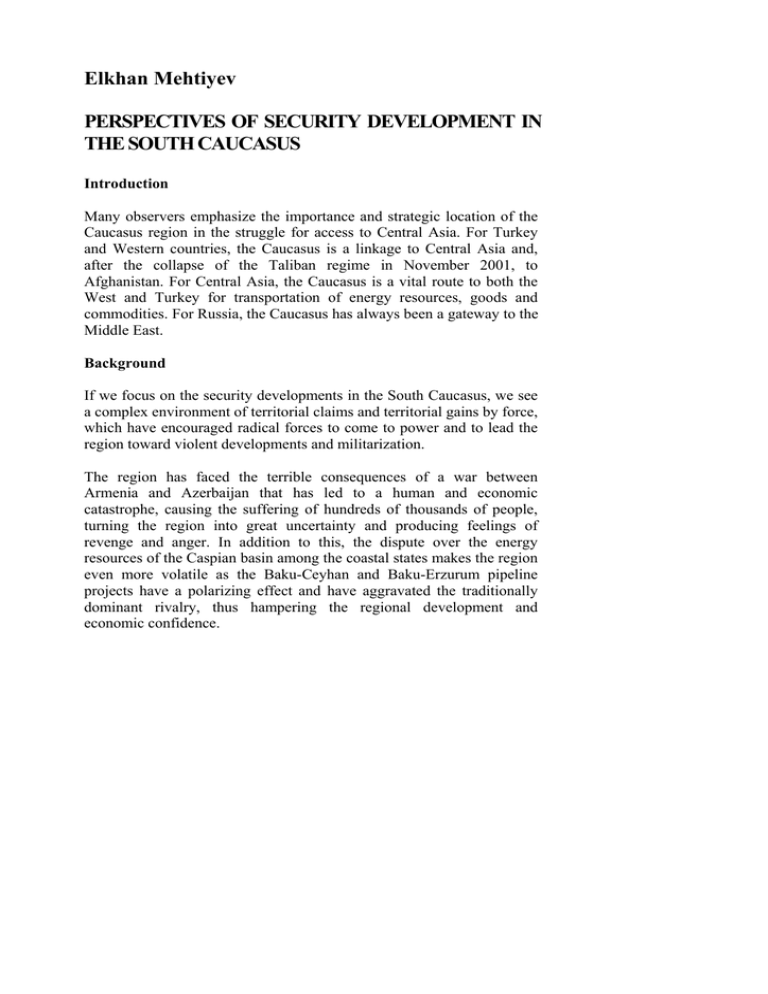
Elkhan Mehtiyev PERSPECTIVES OF SECURITY DEVELOPMENT IN THE SOUTH CAUCASUS Introduction Many observers emphasize the importance and strategic location of the Caucasus region in the struggle for access to Central Asia. For Turkey and Western countries, the Caucasus is a linkage to Central Asia and, after the collapse of the Taliban regime in November 2001, to Afghanistan. For Central Asia, the Caucasus is a vital route to both the West and Turkey for transportation of energy resources, goods and commodities. For Russia, the Caucasus has always been a gateway to the Middle East. Background If we focus on the security developments in the South Caucasus, we see a complex environment of territorial claims and territorial gains by force, which have encouraged radical forces to come to power and to lead the region toward violent developments and militarization. The region has faced the terrible consequences of a war between Armenia and Azerbaijan that has led to a human and economic catastrophe, causing the suffering of hundreds of thousands of people, turning the region into great uncertainty and producing feelings of revenge and anger. In addition to this, the dispute over the energy resources of the Caspian basin among the coastal states makes the region even more volatile as the Baku-Ceyhan and Baku-Erzurum pipeline projects have a polarizing effect and have aggravated the traditionally dominant rivalry, thus hampering the regional development and economic confidence. Security Arrangements of the CIS in the South Caucasus Collective Security Treaty (CST) The Collective Security Treaty (CST) was signed in May 1992 by Russia, Armenia, Kazakhstan, Kyrgyzstan, Tajikistan, and Uzbekistan in the Uzbek capital of Tashkent. Azerbaijan and Georgia joined it in late 1993. Azerbaijan’s decision was prompted by indirect assurances of the Russian leadership to former president Haydar Aliyev, that they would support Azerbaijan’s struggle against the Armenian forces. This policy soon proved to be short-sighted and in early 1999, Azerbaijan, Georgia and Uzbekistan withdrew from the CST. Azerbaijan mostly criticized that CST did not take a firm stance on Armenia’s occupation of another CST member country’s territory and that there was consequently no need to prolong membership. The recent reorganization of the CST into the Collective Security Treaty Organization (CSTO) has created suspicions. The structure of the CSTO envisages the build-up of unified headquarters for the operative management of the Rapid Reaction Forces (RRF) formed in three directions with regional commands282. The structure of the CSTO is similar to the former Warsaw Pact, but has its own specifics: The highest body of the CSTO, the Collective Security Council, is composed of the heads of states of the six member countries. Furthermore, the CSTO has a Council of Foreign Ministers, a Council of Defense Ministers, a Committee of the Secretaries of the Security Councils, a Permanent Council of special representatives of the member states, and a Secretariat, the highest coordinating body, with a Secretary General. Russian president Vladimir Putin has argued that the CSTO will counter the threats posed by the drug trafficking from Afghanistan and by radical Islamic groups in Central Asia. In reality, the organization is a tool of Putin’s CIS doctrine to keep the former Soviet republics in Russia’s “political orbit” and to challenge the US advance in the area. The 282 Namely „Western“ in Belarus (Russia, Belarus), „Caucasus“ (Russia, Armenia) in Armenia and „Central Asia“ (Russia, Tajikistan, Kazakhstan, Kyrgyzstan) in Kazakhstan. purpose is to preserve or to restore the presence of Russian military forces in the former Soviet Union through multilateral. The Caucasus group was planned as a joint Russian-Armenian RRF of about 10.000 soldiers under joint Russian-Armenian command. This intention was confirmed again by Russian Defense Minister Sergey Ivanov during his visit in Armenia in November 2003: “We will work on creating a combined Russian-Armenian group of troops. Our general staffs are working on this,” he said. This was assessed by former Georgian president Eduard Shevardnadze as “incomprehensible to Georgia and Azerbaijan.” Other Regional Structures The so-called “Caucasus Four”, Azerbaijan, Armenia, Georgia and Russia are greatly concerned with security issues at the presidential, parliamentarian and intelligence level. Since Azerbaijan and Georgia are not represented in the CSTO, it serves as a substitute security forum without military components. But it is clear that the “Caucasus Four,” too, are expected to promote Putin’s above-mentioned approach. Another regional structure is GUUAM283. Its member states Georgia, Ukraine, Uzbekistan, Azerbaijan and Moldova pledged to cooperate multilaterally in peacekeeping efforts and to promote the peaceful settlement of conflicts, expressing their determination to confront the threats to peace and security at the national, regional and global level. At a meeting in Tbilisi on 24 May 2003, the GUUAM member countries and the United States discussed joint projects designed to improve the regional security by developing so-called “virtual centers” to combat terrorism, drug trafficking and other crimes and to launch border security and customs control projects, intended to facilitate trade and transportation. Some other regional security initiatives such as Caucasian Stability Pact that envisioned the disintegration of foreign military bases from South Caucasus, establishing peace and security in the region and developing 283 "http://www.guuam.org". closer economic cooperation. The initiated formula “3+2+2” and later “3+3+2” (the three Caucasian states plus Russia, Turkey and Iran plus EU and the US) had no success due to the joint Russian-Armenian stance that the Russian military presence in the South Caucasus should be a major component of a new system of regional security. As a member of the CIS, the three Caucasian countries are participating in its political, military and security bodies like the CIS Council of Defense Ministers and the CIS Council of Ministers of the Interior. In these councils, the national representatives discuss military cooperation, cooperation on border protection, the collective combat of crime, terrorism and drug trafficking and bilateral cooperation on legal assistance. An own Anti-Terrorist Center has been set up to combat terrorism and to prevent their incursion in the CIS. After the removal of Saddam Hussein in Iraq in April 2003, Iranian Foreign Minister Kamal Kharrazi visited the South Caucasus, Turkey and Russia in order to promote the Iranian model of a regional security arrangement. As many experts argued, the Iranian proposals were aimed at countering the increased US presence in the region. However, Russia’s silence and the Georgian and Azerbaijani bid for NATO membership have torpedoed the Iranian initiative. Relations with NATO Azerbaijan is very active in the framework of the Partnership for Peace (PfP) program and other NATO initiatives. Former president Aliyev confirmed at several occasions Azerbaijan’s intentions to join NATO. Azerbaijan’s society supports this initiative, as the membership process is considered as an important step towards democratization and transparency. But Azerbaijan’s aspirations for closer security relations with NATO provoke rather harsh reactions of some of its neighbours. Iran considers Azerbaijan’s strive for closer cooperation with NATO as a hostile action since they consider the alliance as US-dominated. In Tehran, the NATO expansion is perceived as an American attempt for regime change in Iran and a US ally close to its borders is thus considered a threat.284 There are signs of an Iranian-Russian counterbalance in the region to contain NATO influence. However, Russia’s NATO policy and the recent events in Iraq have changed the regional environment. The Iranian government adapted its position consequently and Kharrazi said that Iran would respect the decision of its neighbour countries to join NATO. Despite Russia’s representation in Brussels, the old thinking in the security and foreign policy establishment in Moscow led to an enhancement of Russian military presence in the North Caucasus and particularly in Armenia, intended to counter the rapprochement of Azerbaijan and Georgia with Turkey, the US and other NATO members. If we look at the Russian North Caucasus, in immediate proximity to Azerbaijan and Georgia, we see an enormous accumulation of Russian forces. Russia maintains enormous troops285; a fact that contradicts the Russian obligations under the CFE treaty. During his visit to Armenia in November 2003, Russian Defense Minister Sergey Ivanov said that Armenia is Russia's major strategic partner in the Transcaucasia. It is the only member of the CSTO which shares a border with NATO countries. […] 5.000 Defense Ministry servicemen, plus the Russian border guard troops in Armenia are enough, but we are not happy with the military equipment”, he said. And: “We will rearm and re-equip the Russian 102nd military base in Armenia.” Azerbaijan has repeatedly protested against Russian military supplies to Armenia, considered incompatible with Russia’s mediation activities in the Nagorno-Karabakh conflict. 284 285 The Iranian side has repeatedly expressed its opposition to American oil companies’ involvement in the Caspian basin and development of bilateral Azerbaijani-Turkish and Azerbaijani-US security cooperation. From Tehran’s point of view, they complicate the bilateral relations with Azerbaijan. According to Russian sources, the 58th army, the VDD 7, the marines brigade no 77, the special task forces, border troops and troops of the Ministry of the Interior are deployed in the North Caucasus. Not taken into consideration the troops of the Ministry of the Interior, the Russian military presence amounts to 300.000 troops deployed in Southern Russia; 80.000 of them in Chechnya. A further 100.000 soldiers of the Ministry of the Interior are located in the North Caucasus. Georgia is steadfastly determined to join NATO. Former Georgian president Eduard Shevardnadze made an official announcement at NATO’s Prague summit in November 2002. In his radio address in Tbilisi afterwards, Shevardnadze said that he regarded the alliance as a “guarantee for Georgia’s security.” In this regard, the US-led “Train and Equip” program could create the framework for a professional army which will allow Georgia to join the Euro-Atlantic military and political sphere in the next few years and, eventually, to join NATO. Currently, a total of four battalions is expected to be trained under the “Train and Equip” program, but it will certainly be extended. The program irritated Russia, which delayed the dismantling of its two remaining bases in Georgia, whereas Tbilisi insists on a complete withdrawal within three years. The situation is different in Armenia. It hosts the Russian military base no 102 and Russian border troops (on the borders with Iran and Turkey). The Armenian-Russian military agreement, concluded in March 1995, is valid for 25 years with extension for another five years, unless any side terminates it. Armenia has signed military agreements with Belarus and China as well. Further, Armenia is the only member of the CST in the South Caucasus. Its leadership has stated clearly that the country will not seek NATO membership, but to continue to be part of the CST. Armenia opposes Azerbaijani and Georgia’s NATO bid, arguing that their membership in the alliance would change the regional landscape. For Yerevan, a NATO expansion to the South Caucasus would create new dividing lines and aggravate the problems of the region. The Armenian leadership strives to keep the current status quo, which is used as leverage for internal politics. A disturbing factor for Azerbaijan is that unofficial NATO sources still say that a possible Azerbaijani membership bid should be balanced with Armenia, while Yerevan clearly sees Russia as a guarantor for its security. Another aspect of the Armenian security policy is that Armenia-NATO and Armenia-US military relations are developing; Armenians call this a „four-staged security policy. “ Military-technological relations with Russia and military-technical relations with the CSTO members are the core of this policy, supplemented by the development of bilateral relations with NATO and the US. Looking at Armenia from the outside, one may judge that Yerevan is pursuing a policy qualified as “Realpolitik”. Armenia will wait until the transformation of NATO and its relations with Russia are completed. By cooperating with NATO, Armenia prepares itself to any possible development. From the Azerbaijani perspective, Yerevan’s cautious approach to NATO is related with the total dependence on Russian military support for pursuing Armenian policy in the Caucasus. The countries of the South Caucasus and Central Asia should concentrate more on internal security, which is not dealt with by NATO, but by the national governments. Security cannot be guaranteed if authoritarian rulers and warlords continue to ravage their countries, causing corruption, emigration, human trafficking and clan monopoly over the resources, thus restricting basic and human rights. At the Madrid meeting of NATO-EAPC foreign ministers on 4 June 2003, the Secretary General of NATO, Lord George Robinson, emphasized the importance of democratic transformation for an enduring security and stressed the need for democratic transformation in the Euro-Atlantic area as a major security investment. But fraud of national and local elections is a common feature in all three South Caucasus countries, as well as corruption, the lack of transparency (including the security sector), the state monopoly over the media and the restricted political activities of the civil society. The Caspian energy resources affect not only Azerbaijan, but also Georgia and Armenia. Azerbaijan has already seen the installation of a dynastic regime by the power transfer from father to son, accompanied by a brutal repression against political opponents. The concentration of property and energy revenues in the hands of ruling elites will lead to huge disparity in the living standards in all three countries and might cause systematic unrest (which is already the case in Azerbaijan and Georgia). Furthermore, Azerbaijan has already serious tensions with Iran and Turkmenistan over the Caspian Sea energy resources. Iran has long disputed the status of the Caspian Sea, demanding its division into five equal parts, in violation of Azerbaijan’s sovereignty in its sector of the Caspian Sea. Tehran also opposes the Azerbaijani-Russian and RussianKazakh agreements on the division of the Caspian Sea. In Azerbaijan’s case, the national security is compromised by the increasing poverty, unemployment, rampant corruption, social unrest and religious radicalism. An estimated two million Azerbaijanis emigrated to Russia to earn money for their families. Azerbaijan has the highest rates of child mortality in the former Soviet space, while prostitution has dramatically increased, spreading from Europe to Gulf Arab countries, and women trafficking is a prospering business with impunity. When it comes to the relations between Azerbaijan and Turkey, Baku views the Turkish presence in the region as a factor of security, proved by Turkish cooperation with Georgia and Azerbaijan for the past ten years. This cooperation gives an additional momentum to Azerbaijan’s and Georgia’s aspiration for NATO accession and further stabilizes the region. Azerbaijan does not yet have a security treaty with Turkey, similar to the above Armenian-Russian document, but Azerbaijan’s society is inclined towards more Turkish military involvement in the reconstruction of Azerbaijan’s army. Until now, the military cooperation with Turkey is limited to the formation of a Council on Military Cooperation with office in Baku. The council is responsible for the training of Azerbaijani officers in Turkey and in Turkish-led military schools in Azerbaijan. The military training is being conducted according to NATO standards. Turkish interest in the Caspian basin and in Central Asia has traditionally been viewed by Russia as undesirable and as one of the main concerns of its foreign policy. Transportation of energy resources via Turkey to international markets has increased Russia’s opposition. Turkey’s involvement in the region faces resistance from Iran and Armenia as well. The South Caucasus Security Relationship with the US The involvement of American companies in the exploitation and transportation of the energy resources of the Caspian basin and the unresolved regional conflicts in the area are major elements of US involvement. The American-Azerbaijani security dialogue goes back to 1997, followed by a joint statement where the US gave Azerbaijan security assurances. This dialogue found its expression in a statement of presidents Aliev and Clinton in Washington in August 1997, where both parties agreed to explore the opportunities of expanding security cooperation. On 28 September 1999, the US Department of Defense and the Azerbaijani Foreign Ministry signed a weapons security agreement. As a result of this agreement, equipment has been provided for the prevention of the trafficking of WMD and their detection at border checkpoints. The Pentagon has also delivered two patrol boats to patrol the Caspian Sea. Two major factors have dramatically changed the bilateral security relations. After 09/11, Baku sided with the US on the “War against Terror” in Afghanistan, offering security cooperation and allowing American military and transport aircraft to use its air space and airports. The US, in turn, offered to modernize the air defense system and the military airports in Azerbaijan and established a Defense Cooperation section at the US embassy in Baku to boost military-to-military cooperation. For this purpose an equal amount of military aid (4,5 million dollars) were allocated to Azerbaijan and Armenia. AzerbaijaniAmerican cooperation cleared the way for military cooperation with EU countries such as Germany, Italy, and Britain. The Iraq crisis and Azerbaijan’s support for the US military actions in Iraq in 2003 have created a new situation in the Middle East. Azerbaijan’s geographic location, its support of the US and the fact that it is a predominantly Shiite Muslim nation, increased the opportunities for long term allied relationships in the region. Its readiness to join the US-led “coalition of the willing” in Iraq and to deploy peacekeeping forces to Afghanistan was welcomed by Washington. Baku also signed a bilateral protocol allowing American soldiers to bypass the newly established International Criminal Court. All this raised suspicions that Washington strives for military presence in Azerbaijan. The US has consistently emphasized that it looks for ways to invigorate the security of the Caucasus nations through strengthening political institutions and creating an effective participatory governmental system. However, many observers and civil society organizations are increasingly concerned that prevailing military considerations in the US foreign policy could lead to more autocratic regimes in the South Caucasus and in Central Asia. For example, Washington has supported the dynastic regime change in Azerbaijan in October 2003. Recent developments indicate that the US intention to relocate some of its forces from Western Europe to the Caucasus and the Caspian basin are driven by the increasing importance of the Caspian oil reserves as well as by geopolitical considerations. General Charles Wald, deputy US commander in Europe, said: “In the Caspian Sea you have large mineral reserves. […] We want to be able to assure the long-term viability of those resources.” In the Caucasus region, defense officials said that the US was likely to have as many as 15.000 troops, some “rotating through small, Spartan bases in places such as Azerbaijan. However, it should be noted, that the security cooperation between the US and Azerbaijan is to a big extent unilateral, characterized by the ignorance of Azerbaijan’s security interests concerning the continued transfer of Russian military hardware to Armenia.286 But there is little doubt that the current US administration will continue its military commitment in the region. It cannot be ruled out that Washington will even open military bases in Armenia. In Kyrgyzstan, Russian and Western bases already coexist. The American military presence in Georgia has changed the two centuries old geopolitical reality and the political environment and shook Russian dominance in the region. However, the Azerbaijani case is more 286 Russian arms shipments to Armenia in 1993-96 amounted to US $1 billion. The US State Department however referred to “some pieces of Russian equipment” transferred to Armenia. complex since it shares borders with US rivals both in the south and the north. Iran and Russia criticize any military cooperation between Azerbaijan and the US and a possible US military presence in the South Caucasus. Russia considers the Caucasus as its traditional sphere of influence and is not ready to accept any foreign military deployment, not to mention the US army next to its borders. For that reason, the American “Train and Equip” program for the Georgian army has caused fierce initial reactions in the foreign and military establishment in Russia. The climax was a discussion in the Russian State Duma (Lower House of Parliament) and in the press about the possible recognition of the Georgian breakaway regions as sovereign states. The Nagorno-Karabakh Conflict and Security Challenges The occupied territories of Azerbaijan are heavily militarized: the quantity of weapons accumulated there exceed twice the amount of arms in possession of the Azerbaijani army. Large parts of Azerbaijan’s borders with Iran and with Armenia are no longer under Baku’s control. The UN Security Council has adopted four resolutions for immediate and unconditional Armenian withdrawal from the occupied territories, but all of them were ignored by Yerevan, with the tacit support of some Security Council members. Also, Moscow continues to arm Armenia, although Russia is co-chairing the Minsk Group for the settlement of the Karabakh conflict. During the Karabakh war (1991-94) and afterwards, Russia assisted Armenia diplomatically to avert an anti-Armenian coalition. The then Russian Foreign Minister, Andrei Kozyrev, outlined Russia’s position: „What we can do for you is prevention the formation of a coalition against Armenia.” Armenia’s government increased the defense budget 2003 (+20%) and in 2004 (+13%). But even these numbers, as admitted by Defense Minister Serge Sarkisyan do not contain the complete military expenditures of Armenia: The budgetary funds are not the only financial source of the Armenian military, as weapon transfers are carried out through the black market. The Armenian military is expected to account for the biggest single share of government expenditures. The question at stake now is how to ensure the state security of Azerbaijan. On the one hand, Azerbaijan had also increased its defense expenditures for the year 2003, which amounted to US $140 million. Azerbaijan's draft defense budget for 2004 is to rise by 7 percent, amounting to US $146 million. On the other hand, the elimination of Armenian weapons in the occupied territories is the security issue number one for Azerbaijan. Military operations to liquidate them would again lead to a full scale war between the two countries. Thus, the activities should be started by verifying the CFE obligations in the region. CFE inspectors should be mandated for verification and inventory of uncontrolled weapons in the region, their elimination or at least withdrawal should be part of any peace agreement. These measures also require further international involvement in the region. Azerbaijan side is ready for peace but does not accept the annexing of its land by force. Recent developments in Azerbaijan and Armenia do not give hope for the near future. Armenia has a militarist government that lacks clear-cut visions of how to shape relations with its neighbours. The former Armenian president, Levon Ter-Petrosyan, called the current Armenian leadership a “war party”. Azerbaijan has a corrupt authoritarian dynastic regime without any political will. It is equally incapable to overcome the current impasse. Neither war no peace has also been serving to the current regime’s interests since change of the status quo requires creative and intensive work which is alien to a system based on bribery and corruption. Elkhan Mehtyiev Peace and Conflict Resolution Center Baku
